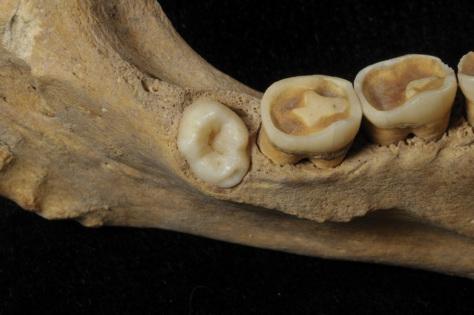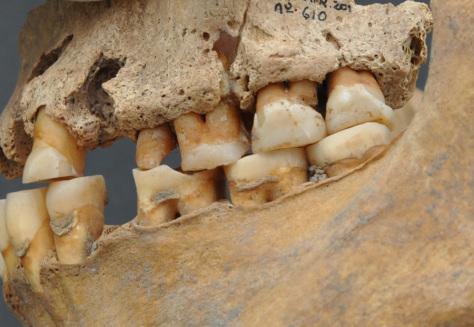IPHES
Source - https://iphesnews.wordpress.com/2015/04/22/an-extra-molar-is-identified-for-the-first-time-in-an-atapuerca-hominid/
The presence of a fourth or extra molar in ancient populations is recognized for the first time by a scientific publication This individual suffered dental decay, abscesses, pulpits, periodontal disease, severe dental wear and tooth picking marks.
Human dentition is composed of 3 molars in each side of the mandible and maxilla. An extra tooth (supernumerary tooth) is something really weird. In present-day populations ranging from 0.1% to 3.4%. Instead this is an ancient phenomenon. A recent article on the journal HOMO – Journal of Comparative Human Biologydiscloses the presence of one individual of about 40 years old, probably a male, with a fourth molar and important dental pathologies. This individual was recovered from a collective burial known as Cueva de El Mirador in Burgos, Atapuerca, and dated around 4,760 and 4,200 years ago.

An extra molar is something really weird – IPHES
It is the first time a scientific journal published the existence of this phenomenon in ancient populations and is also the first case identified in Atapuerca. The research is the result of a work carried out in collaboration between IPHES (Institut Català de Paleoecologia Humana i Evolució Social), the URV (Universitat Rovira i Virgili in Tarragona) and researchers from the Faculty of Dentristy at the Universitat Internacional de Catalunya (UIC). Marina Lozano, IPHES researcher and professor at the URV, one of the authors of the article says: “In the case of archaeological populations there are very few studied and published examples of supernumerary teeth. Therefore, it is a novelty”.

This individual suffered severe dental wear and a variety of oral pathologies – IPHES
This individual suffered severe dental wear and a variety of oral pathologies such as, dental decay, abscesses, pulpitis, periodontal disease, toothpicking marks in an upper molar, and arthritis of the temporo mandibular joint (between the temporal bone and the mandible). “This diagnosis confirms that oral health from the Neolithic became worse in agriculture and livestock populations. An aggravated fact, by the lack of palliative treatments”, says Marina Lozano. This is because during this period the diet changes: it includes, for example, more cereals, foods that have more starches and carbohydrates, which increases the proportion of dental caries, disease that is result of carbohydrates consuming and a lack of dental hygiene. “For a better diagnosis the remains have been analyzed using Cone-Beam Computed Tomography (CBCT, acronym in English)”, says the same researcher. This technology, which provides 3D images, has helped to define the inner body structures of the fourth molar, and to determine the absence of other supernumerary teeth in this individual.
Reference
Ceperuelo, D., et al., “Supernumerary fourth molar and dental pathologies in a Chalcolithic individual from the El Mirador Cave site (Sierra de Atapuerca, Burgos, Spain)”,HOMO – Journal of Comparative Human Biology(2015)